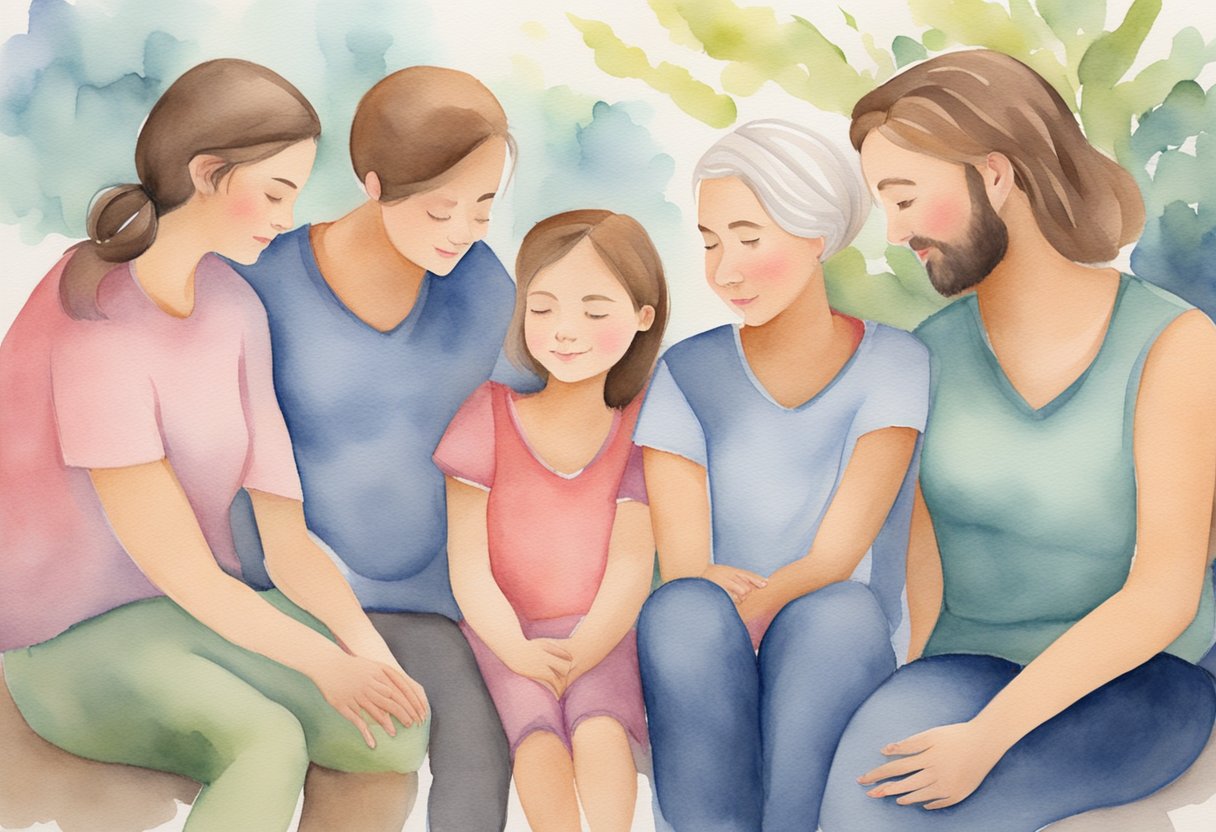Strategies for Emotional Resilience

Coping with the emotional aftermath of cancer is a journey many of us face, a road that can be as daunting as the disease itself. As a two-time lymphoma survivor, I understand the unique fears and anxieties that come with this diagnosis.
It’s a shared battle that calls for resilience and a steadfast approach to overcome the uncertainties the disease brings along.
Our experience has taught us that while the physical challenges are evident, the psychological hurdles often require equal, if not more, tenacity.
We, as men who have encountered the storm of cancer, recognize the urge to maintain composure and the silent struggle that comes with it. Finding solace in activities that restore our body and spirit, like sports, has been a beacon of hope and normalcy amidst the chaos.
Through engaging in basketball or a calming round of golf, we have found more than an outlet; we’ve discovered a community that uplifts, understands, and drives us toward a healthier state of mind. We draw strength from this brotherhood, aiding each other in staying on course through our fight and subsequent healing—a testament to the power of mutual support and shared experiences.
Key Takeaways
- Emotional resilience is vital for coping with cancer’s psychological impact.
- Supportive communities and shared activities can significantly aid our emotional recovery.
- Keeping occupied with sports provides both physical benefits and mental solace.
Understanding Fear and Anxiety in Cancer
In our journey with cancer, recognizing our emotional landscape is just as crucial as managing physical symptoms. We tackle not just the disease but the fear and anxiety that tag along.
Identifying Symptoms and Causes
Anxiety and fear often wear different masks. We might face sleeplessness, a lack of appetite, or an uncharacteristic short temper. Our brethren dealing with cancer encounter a plethora of triggers for this distress. These can include worry over cancer’s return or the stress of medical visits that bring a unique anxiety known within our circles as “scanxiety.” Our experiences confirm that understanding these symptoms and causes grants us the foresight to navigate these challenges.
Role of Mindfulness and Relaxation
We reclaim control amidst the chaos by arming ourselves with mindfulness and relaxation techniques. Simple practices such as deep breathing, meditation, or even guided imagery can serve as a beacon of calm for us. These methods are not quick fixes but cultivated skills that, over time, build resilience against our anxieties. For us as survivors, especially those who have triumphed over lymphoma, these practices become cornerstones of our survival toolkit. They help us center our thoughts away from fear and towards living fully in the moment. Participating in relaxation training has been a game changer for many of us, offering a strategy to ease the mental burdens cancer thrusts upon us.
Navigating the Cancer Diagnosis
When we face a cancer diagnosis, the path ahead may seem fraught with uncertainty. Here’s how we can chart a course through this challenging time, ensuring clear communication with doctors, managing the shock, building our network, and accessing trustworthy information.
Communicating with Your Doctors
As we embark on this journey, it’s vital to maintain open lines of communication with our healthcare team. We must not hesitate to ask questions, seek clarity on medical terms, and discuss treatment options. Remember, each question we ask shines a light on our path, helping us to understand the nuances of our condition and the steps we can take.
- Questions to Ask:
- What type of cancer do I have?
- What stage is it?
- What are my treatment options?
Coping With the Initial Shock
The moment we hear the word “cancer,” it can send a shockwave through us. Take a breath and permit ourselves to process this news. We should allow ourselves time to accept this reality but pivot towards action and problem-solving. This doesn’t merely soften the blow; it sets us on a proactive course.
Building a Support System
We don’t have to navigate this alone. Rallying family and friends offers us a foundation of emotional support that is critical during such times. Engage with support groups to share experiences with fellow survivors as shared struggles forge powerful bonds. Together, we can face anything.
- Ways to Build Support:
- Reach out to loved ones
- Join a support group
- Connect with cancer survivor networks
Finding Reliable Information
In this era of information overload, pinpointing reliable data can be daunting. We should seek out resources from esteemed establishments like the National Cancer Institute and the Mayo Clinic, which equip us with knowledge without the burden of misinformation. Understanding our diagnosis helps in taming fears and forging a hopeful outlook.
Remember, our shared experiences bind us in the battle against cancer. We stand united, arm-in-arm, resolved to tackle each challenge with the fierce determination of survivors. Together, we are stronger.
Comprehensive Care and Treatment Options

Embarking on a cancer journey demands understanding available therapies and strategies to manage its challenges. We focus on understanding our treatment, managing side effects effectively, and exploring palliative care to ensure our overall well-being.
Understanding Your Treatment Plan
When we face a diagnosis of cancer, grasping the full scope of our treatment plan is crucial. We need to stay informed about the purposes of each therapy, how they target the cancer, and the expected timeline for each treatment phase. It’s not just about the medicines; it’s about staying ahead, knowing why specific treatments are selected for us, and how they fit into the larger battle against the disease.
Managing Side Effects
Side effects, such as nausea, fatigue, and pain, can often seem as daunting as cancer itself. We must take proactive steps to manage these symptoms to maintain our quality of life.
- Nausea: Techniques such as dietary changes and anti-emetic medications can help avoid nausea.
- Fatigue: Adapting our daily activities and incorporating rest into our routine are essential for conserving energy.
- Pain: Engaging with our healthcare team allows us to find the most effective pain management strategies tailored to our needs.
The goal is to mitigate these side effects, so they interfere as little as possible with our daily lives and allow us to focus on recovery.
Exploring Palliative Care
Palliative care is an ally in our corner, especially when dealing with the stress and symptoms of cancer. It’s a layer of support that goes hand in hand with curative treatments, focusing on relieving symptoms and anxiety, thus enhancing our quality of life. Whether it’s helping us stay comfortable, managing our appetite, or addressing emotional stressors, palliative care gives us the comprehensive support we need.
Developing Coping Strategies
As survivors of lymphoma, we understand the weight of fear and anxiety. We find strength and equilibrium by embracing proven coping strategies.
Cognitive Behavioral Approaches
We give power to our thoughts – they shape our emotions and behaviors. Cognitive Behavioral Therapy (CBT), a solution-focused approach, teaches us to identify and challenge unhelpful thinking patterns. Restructuring these thoughts reduces distress and enhances control over our fears. For further insights, review explanations provided by the National Cancer Institute.
Physical Activity and Exercise
Engaging regularly in exercise and physical activities fortifies both body and mind. A routine as simple as daily walks or as structured as a gym session helps us manage stress, bolstering our mood and improving sleep. These benefits, deeply rooted in research, aid us in maintaining resilience against anxiety. Activities like swimming or cycling can be both invigorating and therapeutically beneficial.
Creativity and Expressive Outlets
Creative pursuits, such as painting or writing, provide expressive outlets that can be profoundly therapeutic. These activities encourage mindfulness and offer us a way to externalize the complexities of our journey. A canvas or journal can hold the narrative of our courage, serving as a testament to personal growth through adversity.
Maintaining Relationships and Social Support

Navigating the complexities of life post-cancer, we recognize the tremendous value that robust social support brings to our overall well-being.
The Role of Family and Friends
Our close ones are the pillars of strength and resilience, standing with us as we journey through recovery. In the laughter shared with friends and the solace in family ties, we find a semblance of normalcy amidst uncertainty. We foster these connections for comfort and to build a network that celebrates each small victory on the path to thriving beyond lymphoma.
Participating in Support Groups
Engaging with a support group offers us a platform to exchange stories and strategies for coping. These groups enable us to connect with peers who comprehend our struggle and can offer insights from their experiences. Peer support plays a pivotal role; in these gatherings, we learn not just to receive support but to give it, nurturing a reciprocal relationship that fortifies all members.
Seeking Professional Counseling
At times, the weight of what we’ve endured can feel overwhelming. This is when professional counseling or psychotherapy can guide us toward processing our experiences constructively. Counseling provides a structured environment where we can unearth and confront our anxieties, learning techniques to manage them with the guidance of trained professionals.
Dealing with Common Emotional Challenges

In facing cancer, we often encounter a range of emotional hurdles that test our strength and resilience. Together, we can tackle these challenges head-on.
Addressing Depression and Distress
Depression and distress can become unwelcome companions on our journey with cancer. We recognize these feelings through a lack of motivation, deep sadness, or persistent panic. We must seek support from professionals who offer psychotherapy and consider joining support groups where we can share our experiences and gain strength from others in similar situations.
Overcoming Sleep Disorders and Fatigue
Cancer can turn our nights into a battleground for sleep, and fatigue often seizes our days, leaving us drained. We fight back by establishing a routine for sleep, engaging in regular light exercise to boost our energy, and, when necessary, consulting our doctors for sleep aids. A steady sleep schedule is a fortress against fatigue, ensuring we wake refreshed and resilient.
Reducing Feelings of Isolation
It’s common for us to feel as if we’re fighting alone. However, the connection is our ally. We can reduce isolation by contacting friends, joining cancer support networks, or using technology to stay in touch. Community activities, especially sports or fitness groups, offer dual benefits of social interaction and physical well-being. We are a team, and our unity becomes our strength.
Looking Forward: Survivorship and Future Planning

After facing lymphoma and emerging triumphant, we step into a future where survivorship demands our attention and intention. Let’s map out our journey with tangible plans and strategies to live fully and fearlessly.
Embracing Survivorship
We know the path of survivorship is unique for each of us, forged by personal resilience and shared victories. Engaging with our health care team becomes pivotal in this phase as we transition from patient to thriver. Regular follow-ups and check-ups assure us that we’re not alone in this ongoing battle and allow us to monitor our well-being closely.
Managing Long-Term Anxiety
Anxiety can linger like a shadow, threatening our peace of mind even after we’ve battled cancer to a standstill. Let’s tackle this head-on. Stress management techniques, meditation, and yoga can soothe our nerves and fortify our mental health. Suppose we find symptoms of anxiety disorder or post-traumatic stress disorder intruding into our lives. In that case, it’s crucial to seek support, as early intervention can lead to a more balanced and serene existence.
Creating a Wellness Plan
We craft our wellness plans precisely, knowing that daily habits can build an invincible fortress for our health. Our wellness plan should include:
- Regular exercise tailored to our strengths and interests, be it a solo gym session or a team sport.
- A balanced diet that fuels our body for the challenges ahead.
- Time is set aside for mindfulness practices that reconnect us with the present moment.
Through these strategies, we’re not just planning for a future – we’re actively building it, one health-conscious choice at a time. Let’s boldly chart our course together in survivorship with our eyes firmly set on the horizon of wellness.
Final Thoughts…

As we cross the finish line of our treatment journey, the echoes of fear and anxiety still resonate within many of us. It’s as if the shadow of lymphoma still trails silently long after the stadium lights dim. We, as thrivers, clutch our newfound strength, ready to tackle these lingering specters head-on.
Strategies to Counter Fear and Anxiety
- Meditation & Mindfulness: These practices anchor our thoughts, returning us to a calm resolve.
- Physical Activity: A regular exercise regimen, whether jogging or team sports, redirects our energy to strengthen both body and spirit.
- Support Networks: Conversations in our brotherhood of survivors serve as both a shield and a soothing balm.
- Professional Guidance: Expert advice from therapists is a skilled coach guiding us through challenging drills.
We acknowledge our vulnerability, yet it’s through these shared battles that we forge an even more resilient version of ourselves. Whether in the gym, at home, or in the doctor’s office, we are perpetually sculpting a life that refuses to be defined by cancer.
Together, we transform each moment of dread into a leap toward triumph, never allowing the specter of recurrence to steal our joy. Every whistle and every cheer in our stadiums is a testament to our unwavering spirit.
Cancer tried to disrupt our game plan, but we are running new plays, adapting with precision, and emerging victorious. Our camaraderie is relentless; our tactics are ever-evolving. And just like the finest athletes, we rest, strategize, and return to the field stronger, ready to impart wisdom and extend a helping hand to those fresh on the path. -T
Frequently Asked Questions
In this section, we address common queries to aid us in our journey beyond cancer, focusing on practical strategies and mental health tips tailored for us as men who have faced such challenges.
What are effective strategies for managing anxiety after receiving an all-clear from cancer?
Regular exercise proves to be a powerful tool for us to keep anxiety at bay, promoting overall well-being. Techniques like deep breathing and mindfulness can ground us, especially in moments when post-cancer anxieties loom.
What are common emotional challenges faced by individuals after cancer treatment, and how can they be addressed?
Many of us wrestle with a mix of relief and new stress after treatment. Establishing a strong support network and perhaps seeking counseling can provide us with the resilience to navigate these emotional hurdles.
How can one cope with the fear of cancer recurrence?
The specter of recurrence haunts many of us. Engaging in activities that bring joy and purpose can redirect our focus. Regular check-ups afford us reassurance, and we equip ourselves with knowledge about symptoms to watch for.
What are the best ways to handle the stress related to cancer scares?
When facing potential cancer scares, we need to lean on trust in medical professionals and the facts. Scheduling discussions with our healthcare team can alleviate stress through clarity and timely action.
What techniques can help maintain a sense of calm when suspecting you might have cancer?
Maintaining composure begins by gathering reliable information and avoiding hasty conclusions. Being mindful and staying focused on the present, rather than dwelling on hypothetical scenarios, enables us to preserve our balance during times of uncertainty.
How can one differentiate between realistic concerns and unrealistic fears regarding cancer?
Realistic concerns stem from actual symptoms and a doctor’s advice, whereas unrealistic fears often emerge from our mind’s worst-case scenarios. We learn to trust our medical team’s guidance and knowledge about our body’s normal functioning to distinguish between the two.
